“`html
Introduction
People today often find themselves living in smaller spaces, whether it’s a cozy apartment in a bustling city or a compact tiny home in the countryside. Maximizing these small spaces can be challenging, but there is a smart and efficient solution—minimalist furniture. Choosing minimalist furniture for small spaces not only aids in functionality but also elevates the overall aesthetic appeal of the home.
The Essence of Minimalism
Minimalism in furniture design emphasizes simplicity and functionality. It focuses on clean lines, lack of clutter, and multifunctional pieces that serve more than one purpose. This design philosophy is especially beneficial for those living in small spaces where every square foot counts.
Benefits of Minimalist Furniture for Small Spaces
1. Space Efficiency
One of the main benefits of minimalist furniture is its ability to maximize space. Research indicates that 55% of homeowners today prioritize space-saving tactics when choosing furniture for small areas (source: Home Design Trends Report, 2023). Minimalist designs often include multipurpose pieces, such as sofas that convert into beds or tables with storage compartments.
2. Enhanced Aesthetic Appeal
Minimalist furniture brings a modern and sleek look to any space. The simple design elements create a sense of openness and calmness. They also reflect light better, making rooms appear larger and more inviting.
3. Easy Maintenance
With fewer intricate details and embellishments, minimalist furniture is generally easier to clean and maintain. This can be especially beneficial in small spaces where functionality takes precedence, and keeping things spick and span is crucial.
4. Cost-Effectiveness
While minimalist furniture can sometimes be seen as an upscale choice, there are affordable options available that offer elegance without breaking the bank. Furthermore, investing in durable and timeless pieces means less frequent replacements and thus, long-term savings.
| Feature | Benefit |
|---|---|
| Space-Saving Design | Increases available space by 25% when optimizing room layout (source: Living Space Study, 2023) |
| Multipurpose Functionality | Reduces the need for additional furniture in small areas by 40% |
| Simplified Cleaning | Decreases cleaning time by 30% due to fewer surfaces |
Key Design Principles
When integrating minimalist furniture into small spaces, several key design principles should be considered. Firstly, they should select pieces that are multifunctional. For instance, a minimalist coffee table with storage space or a bed with drawers underneath can provide additional utility without consuming extra space.
Secondly, they should opt for neutral color palettes. This will help in creating continuity and openness, as lighter colors make confined spaces seem airier and more spacious. Picking furniture that blends with the wall colors also helps the room feel more expansive.
Finally, they should embrace open storage solutions. Instead of closed cabinets that visually cut off sections of a room, open shelving encourages organized and visually appealing displays.
Overcoming Common Challenges
While embracing minimalist furniture in small spaces offers numerous benefits, people may encounter some challenges. Finding the right balance between minimalism and functionality is key. It’s important for individuals to only select pieces that align with their lifestyle needs. Consulting interior design experts or utilizing 3D room planning tools can aid in visualizing the potential of their space when furnished with minimalist pieces.
Key Takeaways
- Minimalist furniture maximizes space efficiency for small living areas.
- It enhances aesthetic appeal and can make rooms appear larger.
- Such furniture is easy to maintain and often cost-effective in the long run.
- Key design principles include opting for multifunctional furniture, neutral color palettes, and open storage solutions.
- Overcoming challenges involves carefully selecting pieces that fit lifestyle needs.
FAQ
- What defines minimalist furniture?
Minimalist furniture is characterized by its simplicity, functionality, lack of clutter, and emphasis on clean lines. - Why is minimalist furniture ideal for small spaces?
It maximizes space efficiency through multifunctional designs, enhancing both usability and aesthetic appeal. - Can minimalist furniture be affordable?
Yes, there are several affordable minimalist options that don’t compromise on style or durability, leading to long-term savings. - How much can minimalist furniture increase available space?
According to a Living Space Study, optimizing layout with minimalist designs can increase available space by up to 25%. - How do they maintain a minimalist look in small areas?
They should choose neutral color palettes, multifunctional pieces, and implement open storage solutions to maintain a sleek, minimalist look.
“`
